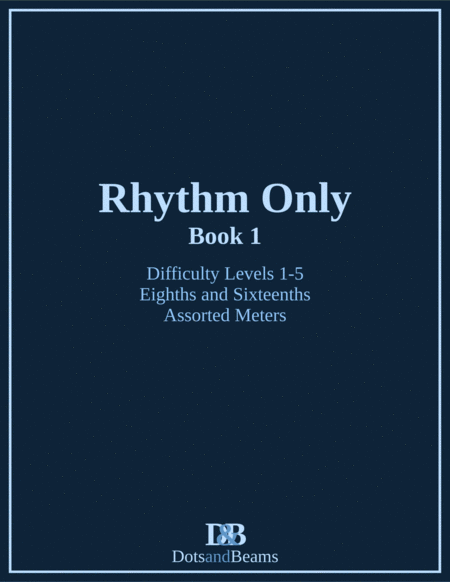Large Ensemble Alto Recorder,Alto Saxophone,Banjo,Baritone Recorder,Baritone Saxophone,Bass Guitar,Bassoon,Cello,Clarinet,Double Bass,Drum Set,Drums,English Horn,Euphonium,Flute,Hand Percussion,Handbell,Harmonica,Harpsichord,Marimba,Multi-Percussion,Oboe,Orff Instrument,Organ,Piano,Soprano Recorder,Soprano Saxophone,Tenor Recorder,Tenor Saxophone,Timpani,Trombone,Trumpet,Tuba,Ukulele,Vibraphone,Viola,Violin,Voice,Xylophone - Level 1 - Digital Download SKU: A0.931835 Composed by Nathan Petitpas - Dots and Beams. Instructional. Score and parts. 137 pages. Dots and Beams #4776185. Published by Dots and Beams (A0.931835). This collection presents its user with a series of increasingly difficult rhythms on a single pitch. The rhythmic material in this series is organized into 10 difficulty levels. Each difficulty level contains four exercises in each of the following time signatures: 2/4, 3/4, 4/4, 6/8, 9/8, and 12/8. This gives exercises in 2, 3, and 4 beats per bar in both simple and compound meters. The first two exercises of each time signature have no ties while the remaining two exercises in each time signature include ties. In Book 1 of this series you’ll find difficulty levels 1 to 5, while Book 2 completes the set with levels 6 to 10. The exercises in this collection are intentionally random and difficult to internalize. They don’t follow any predictable or standard groove pattern, but instead are random successions of eighth- and sixteenth-note groupings within the prescribed difficulty level. In keeping the rhythmic material as unpredictable as possible the door is left open for the materials to be used in conjunction with any number of exercises, while forcing the user to process every rhythm as its own event without relying on pattern recognition to help in identifying the rhythms. To curate the difficulty of rhythm in as objective a way as possible I looked at all of the possible eighth-note and sixteenth-note groupings within the basic unit of one beat. Each difficulty level builds on the exercises of the previous by adding groupings that are slightly more conceptually challenging. Difficulty Level 9 contains all possible groupings, while Level 10 focuses on the more challenging groupings by omitting easy ones. Some suggestions for how to use this book include: Practice sight-reading. When doing so it is encouraged to cycle through the exercises quickly rather than dwelling on a particular exercise for a long period of time. The goal in practising sight-reading is not to learn the material but to develop the skill of reading new material. Use a metronome! The most important thing you can do with this material is learn how to read these rhythms and play them in time. Advanced metronome work: Place the metronome click on weak beats. With the metronome clicking only on the beat you run the risk of relying on the metronome to give you the time. Placing the metronome click on non-strong beats forces you to take responsibility for the time. For example, instead of putting the metronome click on each quarter-note in 4/4, play the exercise with the metronome giving the second eighth note of each beat, or the last sixteenth note, or beats 2 and 4, or only the downbeat of each bar. Be creative with this one! The possibilities are limitless. Develop independence between hands by playing a repeating pattern in one hand while reading an exercise in the other. Expand on this by adding patterns in hands and feet while reading a rhythm with a remaining limb. This is a great exercise for drummers and percussionists but any instrumentalist could benefit from coordination practice. Use these rhythms to practice scales. Instead of playing scales in straight sixteenth-notes, try playing them in the rhythms given in these exercises. Write in sticking patterns, dynamics, accents, phrase marks, or other articulations for you or your students to practice. If you’re not happy with the ties I included, feel free to add some of your own. Combine the above exercises in any way that you think will be beneficial to your practice. As with any of the Dots and Beams books, the uses for this particular collection are limited only by the imagination of the musician using it. I encourage anybody using this book to find as many uses for these exerci.
